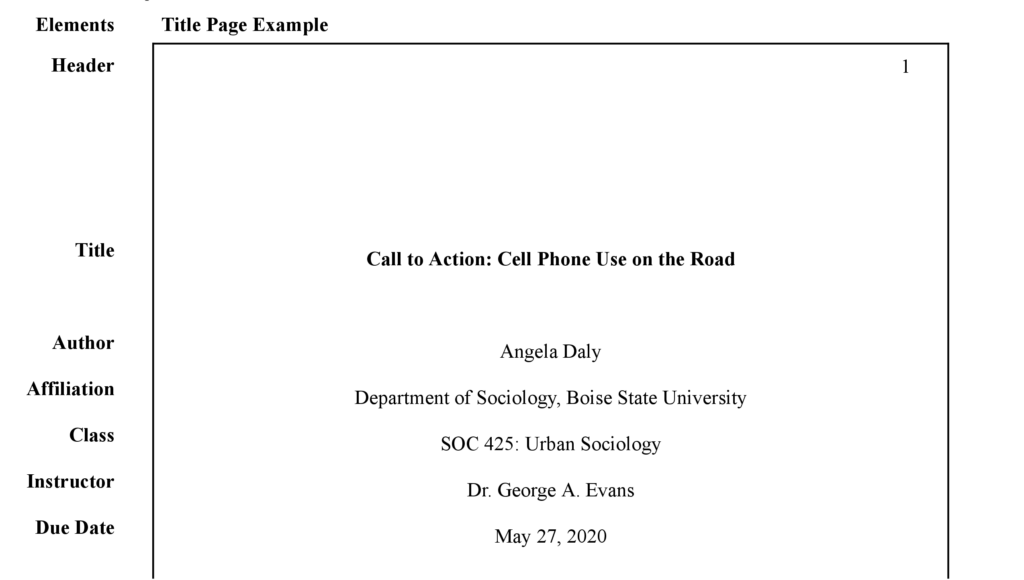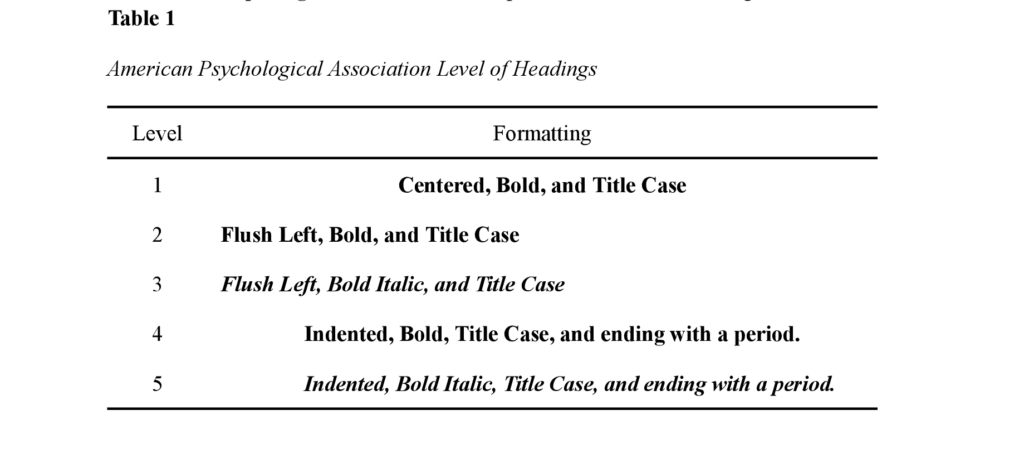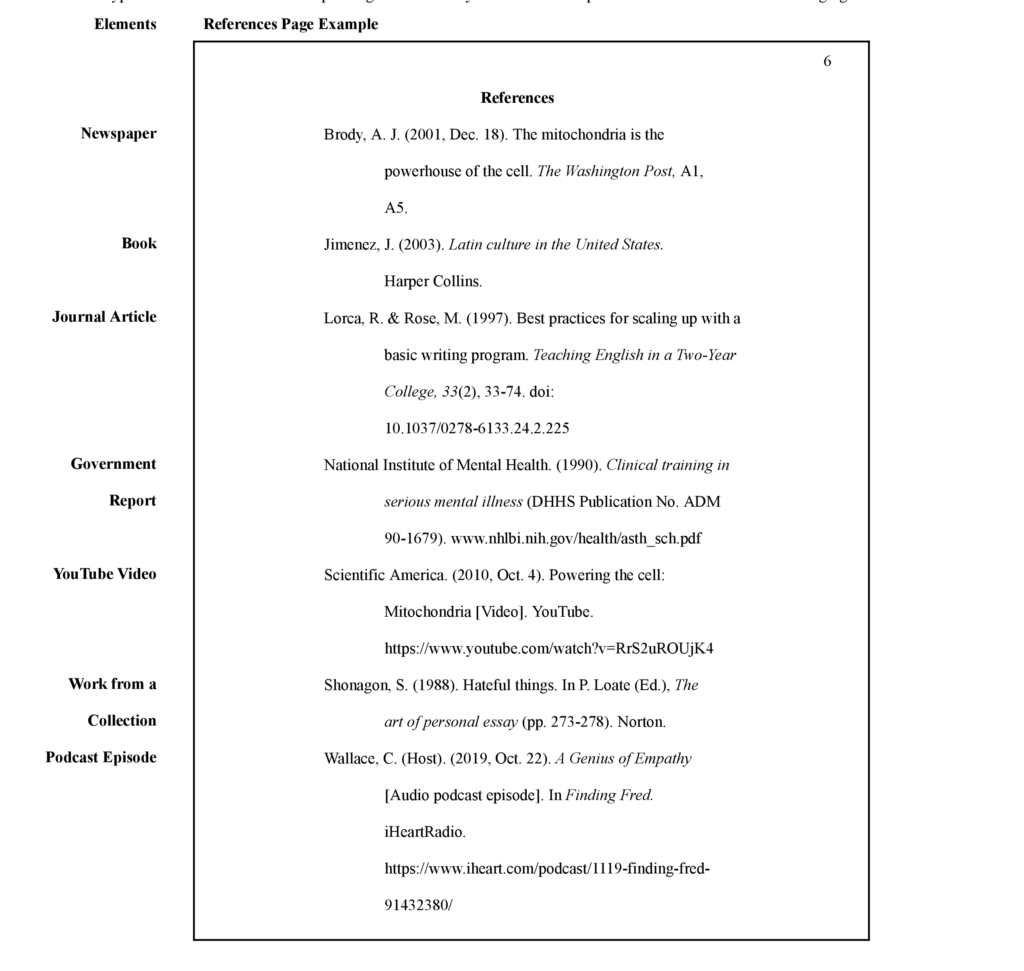Click here to download a .pdf copy of our APA Style Guide!
Last updated: October 7, 2023
Consider keeping a printed copy to have when writing and revising your resume! If you have any additional questions, make an appointment or email us at writing@boisestate.edu!
Source Attribution: Information in this handout is adapted from the Publication Manual of the American Psychological Association, Seventh Edition (2020).
Reference Entry: Adapted from American Psychological Association. (2020). Publication manual of the American Psychological Association (7th ed.). https://doi.org/10.1037/0000165-000
APA Style Guide – 7th Edition
Basics of Formatting with APA Style
The American Psychological Association (APA) style is a system of documentation generally used in the social sciences. It is published in the Publication Manual of the American Psychological Association, Seventh Edition (2020). Fields that use APA style regularly emphasize paraphrasing over direct quotes. Much of the research in these disciplines is supported by lengthy analysis and multiple studies: directly quoting every source can become tedious for authors and readers. Instead, it is common for writers to summarize an idea and then credit multiple sources.
Margins:
Margins are 1 inch on all sides of the page.
Font:
Common fonts used in APA are 11-point Calibri, 11-point Arial, 12-point Times New Roman, and 11-point Georgia. Leave only one space after periods or other punctuation marks.
Paragraph and line spacing:
Indent the first line of each paragraph 0.5 in. Text is double-spaced. No blank space before or after headings or between paragraphs.
Title page:
Each paper begins with a title page. Student papers include page title, author name, affiliation, course name and number, professor’s name, and the date formatted Month Day, Year. Bold title and add empty line between title and author. Start a new page following the title page; the start of page one will repeat the title in bold, centered.
Headers and footers:
List the page number in the top right corner of every page. Student papers no longer require a running head. Running heads for professional papers include a short version of the paper’s title.
Citations:
In-text citations are used to credit any external sources back to your References page. Parenthetical citations include author name, date of publication, and page numbers for direct quotes. Enclose citations in parentheses and follow by a period.
References:
Begin a new page. “References” header center aligned and bolded. List all sources used alphabetically.
Sample APA Student Title Page

APA has two types of title pages: student title pages and professional title pages. Student title pages are more commonly requested by instructors than professional title pages. The example above depicts a common APA title page and a description of the elements within.
- Header: The header lists the page number beginning on the title page. Align to the right.
- Title: Title is placed three to four lines down from the top of the page. Major words are capitalized. Title length may be one or two lines. Avoid abbreviations or non-essential words. A focused title is key!
- Author: Author name(s) includes the first name, middle initial(s), and last name. Two authors are joined with an “and.” Three or more authors are formatted as a list, placing commas between author names, and an “and” before the final author’s name.
- Affiliation: Author’s affiliation lists where the student studies and what school their discipline is within.
- Class: List the course number as abbreviated on course materials, followed by a colon, and spell out the course’s name.
- Instructor: Instructor name(s) include the first name, middle initial(s), and last name. Professional titles such as Dr. or degrees such as Ph.D. are appropriate here.
- Date: Format the date as Month Day, Year. List the assignment due date, not when it was originally created.
APA Level Headings
Headings visually delineate organizational structure and help highlight key ideas within sections. Topics of equal importance share the same level heading throughout the document. The heading style recommended by APA consists of five possible formatting arrangements, which are listed below in Table 1.

Level 1: Centered, Bold and Title Case
Level 2: Flush Left, Bold and Title Case
Level 3: Flush Left, Bold Italic, and Title Case
Level 4: Indented, Bold, Title Case, and ending with a period.
Level 5: Indented, Bold Italic, Title Case, and ending with a period.
More information:
- Ordering: Begin with the first level of headings, using only the heading levels necessary to differentiate.
- Subsections: APA suggests avoiding having only one subsection within a larger section. For instance, Section 1 can be divided into subsections A and B, but not A alone.
- Numbering: Numbering or lettering is not appropriate for headings.
- Spacing: Do not add an extra space before or after headings.
APA In-text Citations
Citing in the Text
In APA, every time you use the work or thoughts of another, you must cite the original author. Use of others’ ideas include summarizing, paraphrasing, and directly quoting. To cite the source, you will need an in-text citation to supplement your references page, typically consisting of the author’s last name and the date when the material was published. Page numbers are added for direct quotes. All of this information is enclosed in parentheses, separated by commas, and followed by a period.
Single Author:
List author’s last name followed by date, adding page numbers for direct quotes. For example, this quotation from Jim Dougan is found on page twenty-nine of his 2017 article:
Single Author Example
After the release of their first album, The Cows were “roundly derided as a talentless, tasteless joke” (Dougan, 2017, p. 29).
Two Authors
Two authors last names are joined by an ampersand as in:
Two Authors Examples
Hansel said goodbye to the white cat, but it was only the morning sun shining upon the chimney (Grimm & Grimm, 1812).
Three or More Authors
List the first author’s last name followed by the abbreviation “et al.” (and others). In this example by John Ramage, John Bean, and June Johnson in their 2012 article, John Ramage is listed as the first author:
Three or More Authors Example
A key component of Aristotle’s classical argument was the rhetorical triangle: the message, writer or speaker, and audience (Ramage et al., 2012).
Organization or Group Author
If no author is listed and or the source is published by an organization or group, list the group’s full name in the text or citation, followed by the abbreviation if well known. Use the acronym for every subsequent citation.
Organization or Group Author Example
According to the American Psychological Association (APA), abbreviations are ok if the abbreviation is well known (2019). After introducing the abbreviation, they recommend using it for every other in-text citation (APA, 2019).
Narrative Citation
If the author’s name, publication date, and or page numbers are given in the sentence, omit them from the following in-text citation. For example: if you introduce the author and date before quoting, summarizing, or paraphrasing, then only the page numbers are included at the end of the sentence.
Narrative Citation Example
According to music critic Mark Prindle (2017), Minneapolis rock combo The Cows are an acquired taste (p. 29).
Unknown Author
If the author’s name is unknown, include a shortened version of the publication title in quotations:
Unknown Author Example
Minneapolis rock combo The Cows are widely considered to be an acquired taste (“All Music Guide,” 2017).
Block Quotations
A direct quotation of 40 or more words is introduced by a colon, started on a new line, and indented a half-inch from the left margin. Do not indent the first line, add quotation marks, or adjust line spacing. Include the parenthetical citation after the final period or punctuation mark of the block quote.
Block Quotations Example
Peterson and Poulsen’s (1998) study found the following:
Mitochondria are known as the powerhouses of the cell. They are organelles that act like a digestive system which takes in nutrients, breaks them down, and creates energy rich molecules for the cell. The biochemical processes of the cell are known as cellular respiration. (p. 199)
Omissions or Alterations to Quotations
Place an ellipsis (…) where parts of a quote were omitted in the middle of the sentence (e.g. “Grammar… is the study of writing techniques”). Ellipses are not necessary to indicate the first part of a phrase was omitted. Put brackets [text] around necessary alterations made to quotations for clarity, as in “[They] said…”
Common Knowledge
Facts or information that you already know, is widely available, and undisputed is considered common knowledge, which does not require an in-text citation. Common knowledge includes biographical information, dates of historical events, and other information that reasonable readers would accept as fact.
Common Knowledge Example
Abraham Lincoln was the 16th president of the United States.
More Information for In-Text Citations
Primary and secondary sources:
To cite a primary source referenced in a secondary source, cite the primary source as cited in the secondary source (e.g. Gilman, 1898, as cited in Eddles & Appelrouth, 2015). Reference the primary source (e.g. Gilman, 1898) directly when possible.
Timed media:
For timed media such as videos or songs, cite the time in parentheses (e.g. Knowles, 2016, 56:37).
Multiple sources:
In-text citations with multiple sources are separated by a semicolon and listed alphabetically (e.g. Smith, 2012; Williams, 2003). However, if delineating the specific attribution is needed, avoid combining the citations and instead separate each source into its own sentence.
Multiple works by one author:
Multiple works by one author are listed chronologically, following the author’s name, separated by commas. Works without dates are placed first (e.g. Smith, n.d., 2007, 2012). If the citations are identical, delineate them by year-letter combination (e.g. Foster, 2011a or Foster, 2011b) in-text and in the References list.
Consecutive use of one or more sources:
When referencing one source multiple times consecutively, you can avoid multiple parenthetical citations by first introducing the source. Refer to the author in text using the known-new contract, adding page numbers for quotes where needed.
Personal communication:
Interviews, letters, emails, and other forms of personal communication are cited in-text only. Cite the communicator’s initials and last name and list the date (e.g. M. Keith, personal communication, August 5, 2022). Where possible, include the author’s name in a narrative citation to avoid the long parenthetical entry.
Reference Entries
Writing Bibliography Entries
Disclaimer: Our WordPress does not allow for “hanging indents,” therefore the bibliography entries below are not formatted with hanging indents. Check out the .pdf guide for a more accurate view!
To credit sources, APA style requires a reference page that includes full citation information for each source. Begin by starting on another page titled “References,” centered and bolded. Reference list entries should be alphabetized by the last name of the first author listed. Additionally, each entry should be indented by a half inch after the first line, called a hanging indent. APA style customizes entries for each type of source, meaning that each citation will be unique.
Webpage from a Website
Website citations follow a basic format for all types of websites. For sources without authors, list the group or organization as author. If no group or organization is given, move the website name to the author position.
Webpage from a Website Example
Last Name, F. M. (Year, Month Day). Title of Page. Website Name. URL.
Boise State University Writing Center. (n.d.). Welcome to the Writing Center. Boise State University. https://www.boisestate.edu/writingcenter/
Book
Books follow a standard format for print and electronic sources. For edited works add the editor’s name following the book title. If no author is listed, substitute for the editor instead. Include DOI for print and electronic sources (if available).
Book Example
Last Name, F. M. (Year). Book Title. Publisher. DOI (if available)
Jimenez, J. (2003). Latin culture in the United States. Harper Collins.
Work from a Collection
Chapters in a wider collection or anthology can be cited in two ways: citing the whole anthology as a book, or citing a single source in the anthology. An example of the latter is shown.
Work from a Collection Example
Last Name, F. M. (Year). Chapter Title. Editor. Book Title (pages). Publisher.
Shonagon, S. (1988). Hateful things. In P. Lopate (Ed.), The art of the personal essay (pp. 273- 278). Norton.
Journal Article
Journal articles, or periodicals, are print and electronic sources issued within larger journals.
Journal Article Example
Last Name, F. M. (Year). Article Title. Journal Title, Volume Number(Issue Number), pages. DOI (if available)
Lorca, R. & Rose, M. (1997). Best practices for scaling up a basic writing program. Teaching English in a Two-Year College, 33(2), 33-74. doi: 10.1037/0278-6133.24.2.225
Newspaper Article
Newspaper and magazine articles are two other types of periodicals. Include volume, issue, and/or page number(s) if available. Unlike other citations, do not list the abbreviation “p.” or “pp.” before the page number(s).
Newspaper Article Example
Last Name, F. M. (Year, Month Day). Article Title. Newspaper Title, pages (if print). URL (if digital)
Brody, A. J. (2001, Dec. 18). The mitochondria is the powerhouse of the cell. The Washington Post, A1, A5.
Government Report
Government reports and other legal documents fall under The Bluebook: A Uniform System of Citation style. List the agency as author and parent agencies as publisher for reports by government agencies.
Government Report Example
Name of Government Agency. (Year). Report Title (Report No.). Publisher. URL (if available)
National Institute of Mental Health. (1990). Clinical training in serious mental illness (DHHS Publication No. ADM 90-1679). www.nhlbi.nih.gov/health/asth_sch.pdf
YouTube Video
Videos from YouTube or other user-generated video websites list the person or group as author. If both the author and username are the same, list the username as author.
YouTube Video Example
Last Name, F. M. [Username]. (Year, Month Day). Video Title [Video]. Streaming Service. URL
Scientific America. (2010, Oct. 4). Powering the cell: Mitochondria [Video]. YouTube. https://www.youtube.com/watch?v=RrS2uROUjK
More Information for Reference Entries
Authors with the same last name:
If a reference list includes authors with the same last name, arrange entries alphabetically by first initial. If both last name and initials are identical, organize chronologically.
Multiple authors:
With sources that have three or more authors, follow the first author’s name with a comma and the abbreviation ‘et al.’ (“and others”).
Organization or group author:
In instances where an organization or group authored the work, spell out the full name of the group but omit initial articles (e.g. a, an, the). If the author is the publisher, skip the author element and begin the entry with the title.
No author:
In a reference entry for a work with no author, move the title of the work to the author position.
No date:
If no date is available, insert the abbreviation “n.d.” (no date) in the date position. For undated, unarchived sources designed to change over time, add a retrieval date, e.g. Retrieved November 7, 2023, from https://www.boisestate.edu/writingcenter/
Publisher:
Publishers’ names are given in full; however, do not give words indicating business structure, like Ltd. or LLC. Terms like Press and Books should be included.
Sample APA References Page
APA references begin on a new page. “References” title is bold and centered. Callouts on the left-hand margin denote the type of citation cited in the corresponding reference entry. All entries are alphabetized and formatted with a hanging indent.
